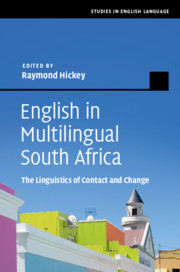Book contents
- English in Multilingual South Africa
- Studies in English Language
- English in Multilingual South Africa
- Copyright page
- Contents
- Figures
- Maps
- Tables
- Contributors
- Preface
- I A Framework for English in South Africa
- Chapter 1 English in South Africa: Contact and Change
- Chapter 2 South Africa in the Linguistic Modeling of World Englishes
- Chapter 3 South African English, the Dynamic Model and the Challenge of Afrikaans Influence
- Chapter 4 The Historical Development of South African English: Semantic Features
- Chapter 5 Regionality in South African English
- Chapter 6 Does Editing Matter? Editorial Work, Endonormativity and Convergence in Written Englishes in South Africa
- II Sociolinguistics, Globalisation and Multilingualism
- III Language Interfaces
- Timeline for South African History
- Glossary
- Index
- References
Chapter 4 - The Historical Development of South African English: Semantic Features
from I - A Framework for English in South Africa
Published online by Cambridge University Press: 07 November 2019
- English in Multilingual South Africa
- Studies in English Language
- English in Multilingual South Africa
- Copyright page
- Contents
- Figures
- Maps
- Tables
- Contributors
- Preface
- I A Framework for English in South Africa
- Chapter 1 English in South Africa: Contact and Change
- Chapter 2 South Africa in the Linguistic Modeling of World Englishes
- Chapter 3 South African English, the Dynamic Model and the Challenge of Afrikaans Influence
- Chapter 4 The Historical Development of South African English: Semantic Features
- Chapter 5 Regionality in South African English
- Chapter 6 Does Editing Matter? Editorial Work, Endonormativity and Convergence in Written Englishes in South Africa
- II Sociolinguistics, Globalisation and Multilingualism
- III Language Interfaces
- Timeline for South African History
- Glossary
- Index
- References
Summary
This chapter analyses the development of over thirty semantic features of South specialisation and re-analysis of words is provided, even where some English words had no endogenous potential to develop in this way. The historical data suggest that the features had propagated considerably by the late nineteenth and early twentieth centuries, whereas the contemporary data show that these features are more likely to appear in the spoken register. More generally, this chapter argues that even though speakers of Afrikaans and South African English have not experienced any identity alignment in the traditional sense, they have maintained a kind of racial affinity within the historical South African context, which has facilitated deep-rooted, reciprocal influence. The unmistakable role of Afrikaans as activating agent in the grammaticalisation process of these features is emphasised. The findings show that the features are often more than transfers and loan translations.
Keywords
- Type
- Chapter
- Information
- English in Multilingual South AfricaThe Linguistics of Contact and Change, pp. 52 - 73Publisher: Cambridge University PressPrint publication year: 2019
References
- 4
- Cited by

